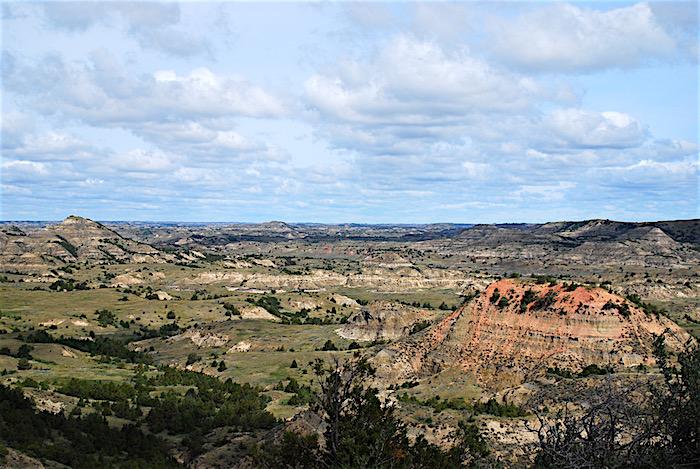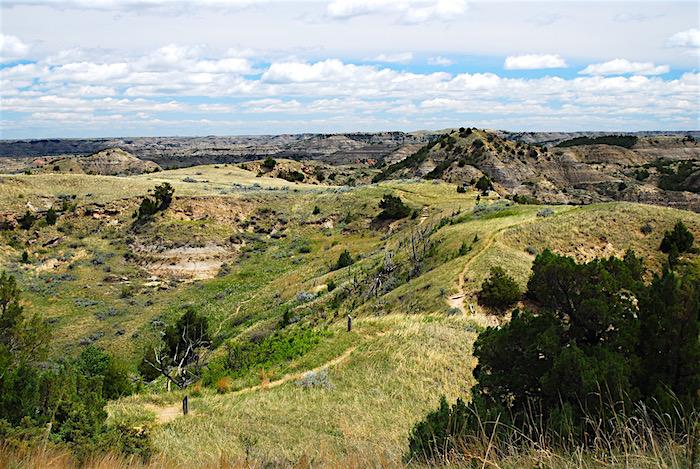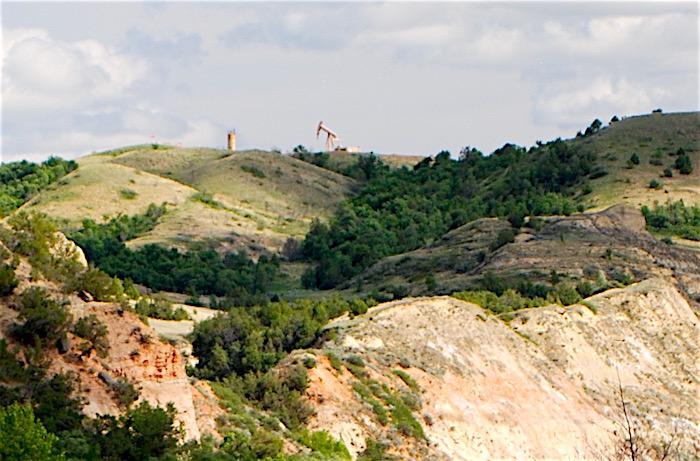
An oil refinery proposed just three miles from the South Unit of Theodore Roosevelt National Park (above) has raised concerns of how it might impact the park's air quality/Kurt Repanshek
While falling oil prices have slowed production from North Dakota's oil and natural gas fields, a company sees that lull as the perfect opportunity to build a crude oil refinery in the state.
However, its proposed location just three miles from Theodore Roosevelt National Park has raised concerns from the National Park Service and conservation groups about how it will impact the park.
At Meridian Energy Group, Inc., the California company behind the $850 million refinery that could process 55,000 barrels of crude a day at full capacity, officials claim their proposed Davis Refinery would be "the cleanest plant ever built."
Others think it's a plant that should never be built in its proposed location.
“They shouldn’t be putting an industrial park next to a national park," Valerie Naylor, the park's former superintendent, said Friday during a phone call. "If this was being proposed within three miles of Yellowstone, Glacicer, Yosemite, or even Mount Rushmore, there would be a huge national outcry. I don’t know why there shouldn’t be a similar outcry about Theodore Roosevelt."
Targeted for a 620-acre swath of farmland between Belfield and Fryburg just east of Theodore Roosevelt, the refinery project is just the latest industrial development pressing in on the 70,447-acre national park. The U.S. Forest Service last year gave the OK for a 25-acre gravel pit across the Little Missouri River from Theodore Roosevelt's historic Elkhorn Ranch and roughly 25 miles from the core of the park's South Unit, while oil pumps dot the landscape in just about every direction. From Buck Hill in the park's South District, gas flares from fracking operations outside the park stand out at night.
The park, of course, was named after Theodore Roosevelt, who came to this landscape as a young man and discovered his conservation bent. The Elkhorn Ranch was where he recovered from the deaths of his wife, Alice, two days after giving birth to their daughter, and his mother on the same day, Valentine's Day 1884. The ranch setting remains bucolic today. While the ranch house is gone, there still stand some of the cottonwood trees that shaded the house and the porch from which the young Roosevelt would escape the heat with a book or simply to rock in his chair while taking in the Little Missouri and the badlands that it carved into the landscape.
Back in 2011, the National Trust for Historic Preservation, citing the gravel pit, named the ranch as one of its 11 most-endangered historic sites in the country. The pit is a byproduct of the oil boom, as it is a source for stone needed for the drill pads rising around northwestern North Dakota. Now, if plans to construct the oil refinery come to fruition, Theodore Roosevelt National Park might claim the distinction of being rimmed by more energy-related developments than any other park in the National Park System.
Oil refineries aren't often built in the United States. Currently, according to the U.S. Energy Information Administration, there are just 137 active refineries. Since the turn of the century, just three refineries have been built, and since 1985 just eight refineries came on line, the agency's records show. Just one of those eight, the Petro Star refinery in Valdez, Alaska, produces as much as 55,000 barrels per day, or as much as the Davis Refinery is designed to produce.
As proposed, the Davis Refinery would produce "(R)efined products include gasoline, diesel, jet fuel, heating oil, as well as lesser-known products such as lubricants, asphalt base, ethane for plastics, waxes and other specialty chemicals. The initial phase of the Refinery will focus on the production of jet fuel, diesel fuel and other distillate products, primarily for local markets."

Park Superintendent Wendy Ross says the refinery, if built in its current proposed location, would be visible from the Buck Hill Trail in the South Unit/Kurt Repanshek
The proposed location is adjacent to a BNSF rail loading facility at Fryburg; the rail line actually runs through the refinery site. Oil and natural gas pipelines are close by, too, according to Meridian.
The property also is near the junction of Highway 85 and Interstate 94. Highway 85 is the main north-south arterial that tanker trucks can use to carry crude from the Bakken field to pipeline and rail terminals.
On their website company officials, noting that more than 95 percent of the daily production from the Bakken is taken out of state for processing, say building a refinery "in the heart of the Bakken will ensure a steady supply of below-market crude oil feedstock from production companies seeking transportation savings and a local market for refined fuels."
Beyond the proposed Davis Refinery, though, Meridian officials expect their plant would attract "compatible industrial process units," according to a zoning application they filed with Billings (North Dakota) County officials. "For example, Meridian has received inquiries from agricultural chemicals firms, brewing companies, and others interested in locating facilities nearby once the Project is in operation," the documents state.
The company produced a promotional video to explain its plans, but blocked public access after the Traveler story appeared.
Ms. Naylor shudders at the thought of such development so close to Theodore Roosevelt's South Unit.
“That industrial park will extend from Fryburg all the way to Belfield if that is the case," she said, referring to the company's expectations of additional buildout. "That would be a really big industrial area right next to the national park. That’s not acceptable.”
Not without irony, the industrial development, if it materializes, would welcome visitors to North Dakota's No. 1 tourist draw, the national park. This year the state's tourism campaign, starring actor Josh Duhamel, focuses heavily on Theodore Roosevelt National Park. And already this year visitation to the park is up more than a third, and related revenues are nearing $40 million annually.
Company officials were traveling Friday and not immediately available to discuss their project.
In their application to Billings County, they are seeking a zoning change to allow the refinery to be built on acreage currently zoned for agriculture. In addition, they want permission to begin site preparation this summer, before the requisite air quality permits for the entire project are issued, "so that the project does not lose this coming summer as part of the construction schedule for the project." According to Meridian, North Dakota officials said "grading and site construction" can begin before the permits are issued.
As planned, the refinery would be operational by 2018.
Beyond the physical siting of an industrial development so close to the park, opponents worry about its impact on air quality. Many national parks, Theodore Roosevelt included, carry a Class I airshed distinction, which requires the highest level of protection under the Clean Air Act. And according to the National Park Service, Theodore Roosevelt "has some of the best visibility and cleanest air measured among all national parks."
However, the agency has pointed out in the past that "(R)egional oil and gas development, as well as nearby mining operations, power generating facilities, and agriculture, contribute to the formation of ozone and haze, sulfur and nitrogen deposition, and deposition of toxic air contaminants (e.g. mercury) at Theodore Roosevelt NP."

Theodore Roosevelt National Park has seen much development on its borders in recent years. This well pump was visible from the historic Elkhorn Ranch/Kurt Repanshek
How the proposed refinery's contributions would affect that air quality is unknown at this stage. Park Service and state of North Dakota air quality officials say they'll conduct rigorous computer modeling to project what that impact might be. That process alone could take a year, they say.
"It’s a little soon to assert whether there will or will not be park impacts. But I can say with a facility of this size, this close to a national park, we’re really concerned," said Bart Melton, regional director of the National Park Conservation Association's Northern Rockies office. "There’s plenty of room in North Dakota for protecting the park and continuing to grow the economy in the Bakken, which, we’re not opposed to that growth. We just want to make sure that it occurs in a way that protects the park and builds the regional economy, too.”
Wendy Ross, Theodore Roosevelt's superintendent for less than a year, has been almost bowled over by the development ongoing around the park. And while the oil boom has slackened somewhat, she said Friday, that hasn't slowed everything down, citing the gravel pit, efforts to expand Highway 85 from a two-lane to four-lane stretch through the park's North Unit, and other infrastructure projects.
But the proposed refinery, she said, has moved to the top of list of projects that concern her.
“I don’t think anybody really realizes how big this is," said Superintendent Ross.
When the superintendent was asked, she couldn't point to another national park that has been faced by such developments closing in on so many sides.
"I really can’t. If you look down the list, I just haven’t seen anything like that," she said.
At the end of the day, said Ms. Naylor, siting a crude oil refinery next door to a national park is wrong.
“I think there are many, many issues, many questions that are unanswered," she said. "In reality, the biggest issue is this big industrial development shouldn’t be within three miles of one of our premier national parks.”



Comments
It's not so black and white. There are "boundaries" and then there are right and wrong ways to think about the development of an area -- not just at the immediate boundary-driven level, but locally, regionally, state-wide, etc. North Dakota can still prosper from the oil without building a refinery right on top of one of this nation's natural and ecological gems. We don't have to live in a Homer Simpson world. http://1.bp.blogspot.com/-SjGQomaE3JQ/TvOguOjodyI/AAAAAAAAAUg/MQjy83Oe2F...
I agree with Judy and Lee. The oil refinery emits odors and toxins into the air that will reach the park. Nothing that has that kind of destructive reach into our National Parks should be allowed. There really is no place that is appropriate for that. Money should be put invested into green sources of energy that preserve life and environment - not this toxic crap.
Um, that's not how property law actually works in this country. You have the right to do on your land what it has been zoned for (and this land is zoned agricultural). You have to get variances to do something different, which is not an unusual procedure but it does require analysis and possibly testing. You don't have the right to do something on your property that negatively affects mine. At least that's how it works with private citizens and small landholders. Big companies often do get away with ruining others' property (think mountaintop coal mininig in Kentucky, as an example) when they are able to muster political intervention.
Freedom certainly does have its costs, and that's why we've balanced the freedom of property owners with the safety net of processes like environmental reviews that ensure that large operations that use or produce toxic or otherwise harmful materials operate in some way that minimizes or eliminates the damage that can be done to neighboring property owners.
Theodore Roosevelt National Park is the property of all US citizens, and not only us but the property of our children and our children's children. No farmer looking to make a profit on a land sale, oil company looking to make some short-term profits on a dying oil boom, or state agencies looking to increase local employment should have the chance to harm it or diminish it.
Unfortunately, Lissa, those "green" sources of energy aren't so green, either, and now threaten 40 million acres of "life and environment" across the public lands of the American Southwest. If it is wrong to place an industrial facility on private lands adjacent to a national park, how is it any less wrong to actually plan for them on our public lands adjacent to our national parks?
Read my article on Soda Mountain and the comments by Interior Secretary Sally Jewell. If our public officials claim to be making hard decisions, then what they ask of us should be hard. But they ask nothing--and do nothing--beyond another technological fix. Green energy is just a fix. The real fix is to live within our means, and no one is proposing that.
Aside from the obnoxiousnouss of this particular refinery, there is the big issue of cumulative impacts.
The U.S. Forest Service, which administers more than 1 million acres of public land surrounding Theodore Roosevelt National Park -- Little Missouri National Grassland -- has allowed unbridled drilling, livestock grazing, mining, predator and prairie dog killing, and other abusive resource extraction activities for years. These exploitative uses are already having a huge impact on the national park. So the refinery in question is just the most recent in a series of harmful activities adjacent to the park.
We need to expand Theodore Roosevelt National Park to encompass all of the national grassland and also to acquire key private lands, such as the tract proposed for this polluting refinery.
Putting oil exploration equipment & a oil refinery so close to park boudaries is reckless. The oil industry's record for land preservation is not good, "How can it be?" Their primary motive is to pull oil out of the ground in the most cost effecive manner. And that is n-e-v-e-r good for the environment. One accident and the landscape is ruined for a lifetime, if not more. This is a b-a-d idea.
Jeffery,
could you provide an example of an oil drilling/extraction accident that led to a lifetime of ruined landscape?
Well, EC, some would say the Deepwater Horizon spill in the Gulf of Mexico will live up to that. While it's only been six years, if you look at the aftermath of the Exxon Valdez spill of more than a quarter-century ago, it seems likely that the aftermath of Deepwater Horizon will linger for quite some time.
And the following is from a 2015 story on Jean-Michel Cousteau's Ocean Futures Society page:
Bottom line is that oil, and materials used to clean up spills, can be highly impactful to the environment.